Analyzing the Effectiveness of Security Measures in Cloud Computing
VerifiedAdded on 2023/04/10
|71
|14520
|443
Report
AI Summary
This report investigates the effectiveness of security measures in cloud computing, focusing on solutions like access control, authentication, and encryption. It identifies security issues and vulnerabilities within cloud environments and proposes recommendations for improvement. The research covers cloud computing concepts, service and deployment models, and associated security threats. The analysis includes quantitative data to assess the efficacy of existing security solutions provided by various cloud service providers, aiming to enhance the overall security posture of cloud computing infrastructures. Desklib provides this document along with many others to aid students in their studies.
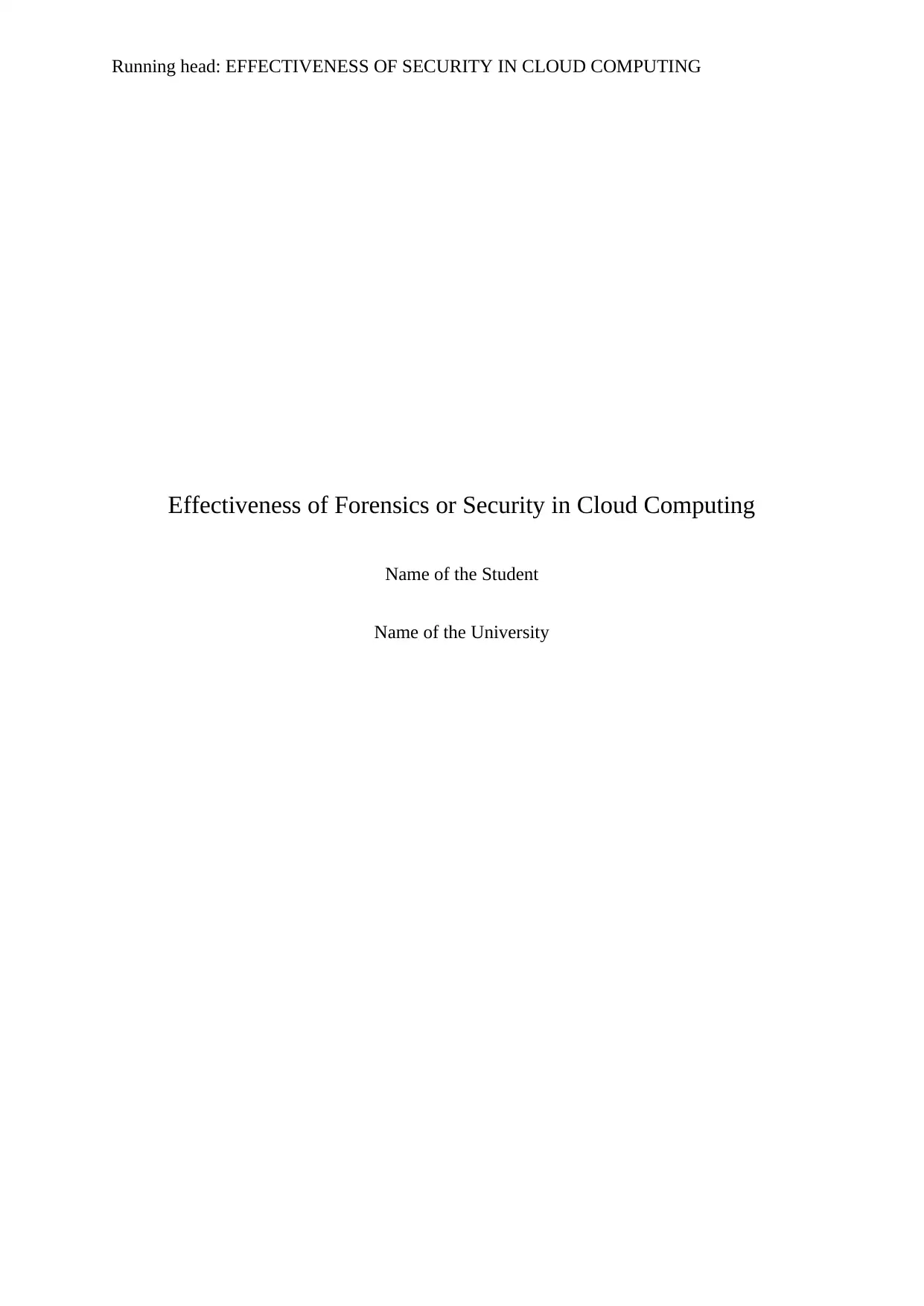
Running head: EFFECTIVENESS OF SECURITY IN CLOUD COMPUTING
Effectiveness of Forensics or Security in Cloud Computing
Name of the Student
Name of the University
Effectiveness of Forensics or Security in Cloud Computing
Name of the Student
Name of the University
Paraphrase This Document
Need a fresh take? Get an instant paraphrase of this document with our AI Paraphraser
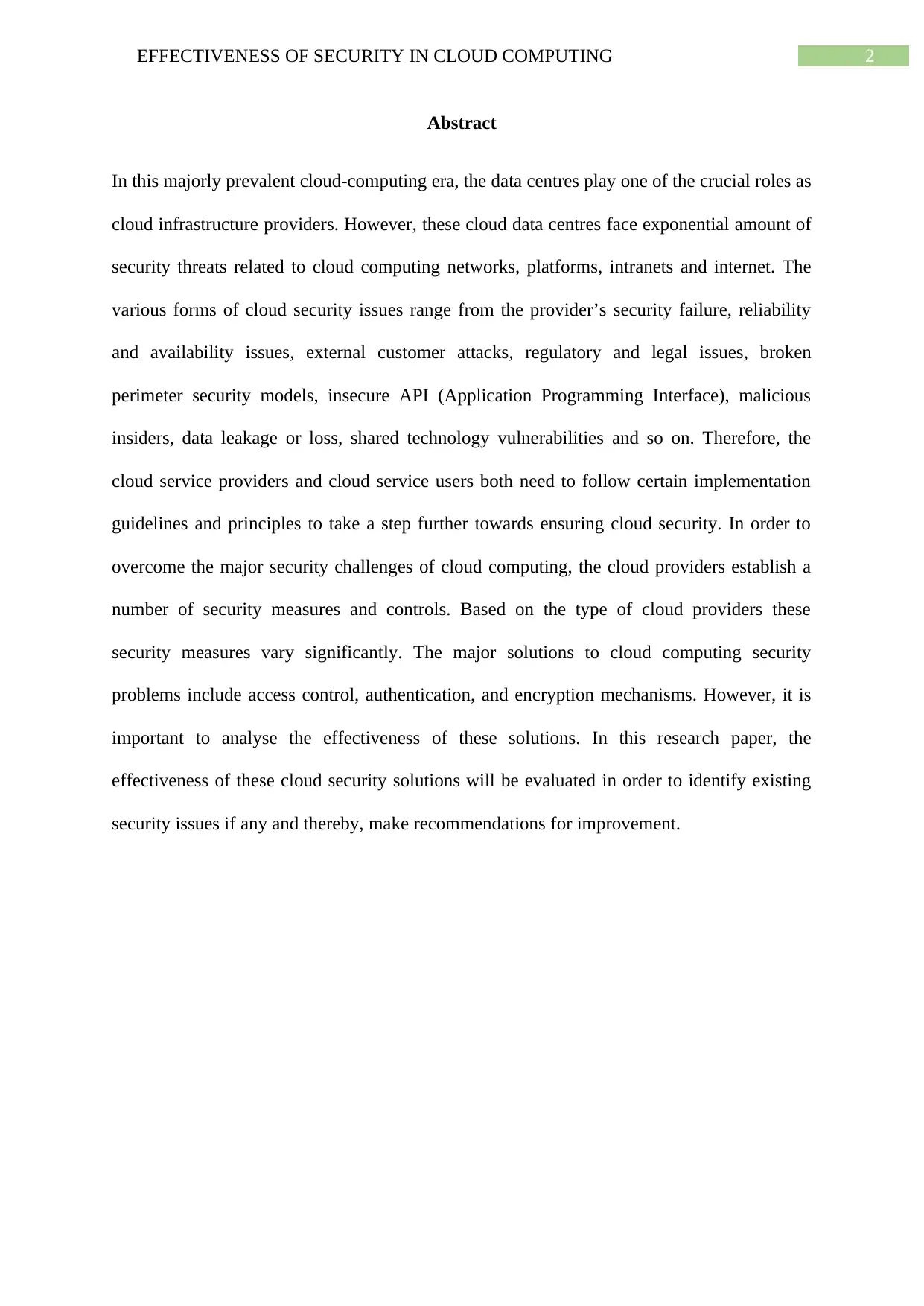
2EFFECTIVENESS OF SECURITY IN CLOUD COMPUTING
Abstract
In this majorly prevalent cloud-computing era, the data centres play one of the crucial roles as
cloud infrastructure providers. However, these cloud data centres face exponential amount of
security threats related to cloud computing networks, platforms, intranets and internet. The
various forms of cloud security issues range from the provider’s security failure, reliability
and availability issues, external customer attacks, regulatory and legal issues, broken
perimeter security models, insecure API (Application Programming Interface), malicious
insiders, data leakage or loss, shared technology vulnerabilities and so on. Therefore, the
cloud service providers and cloud service users both need to follow certain implementation
guidelines and principles to take a step further towards ensuring cloud security. In order to
overcome the major security challenges of cloud computing, the cloud providers establish a
number of security measures and controls. Based on the type of cloud providers these
security measures vary significantly. The major solutions to cloud computing security
problems include access control, authentication, and encryption mechanisms. However, it is
important to analyse the effectiveness of these solutions. In this research paper, the
effectiveness of these cloud security solutions will be evaluated in order to identify existing
security issues if any and thereby, make recommendations for improvement.
Abstract
In this majorly prevalent cloud-computing era, the data centres play one of the crucial roles as
cloud infrastructure providers. However, these cloud data centres face exponential amount of
security threats related to cloud computing networks, platforms, intranets and internet. The
various forms of cloud security issues range from the provider’s security failure, reliability
and availability issues, external customer attacks, regulatory and legal issues, broken
perimeter security models, insecure API (Application Programming Interface), malicious
insiders, data leakage or loss, shared technology vulnerabilities and so on. Therefore, the
cloud service providers and cloud service users both need to follow certain implementation
guidelines and principles to take a step further towards ensuring cloud security. In order to
overcome the major security challenges of cloud computing, the cloud providers establish a
number of security measures and controls. Based on the type of cloud providers these
security measures vary significantly. The major solutions to cloud computing security
problems include access control, authentication, and encryption mechanisms. However, it is
important to analyse the effectiveness of these solutions. In this research paper, the
effectiveness of these cloud security solutions will be evaluated in order to identify existing
security issues if any and thereby, make recommendations for improvement.
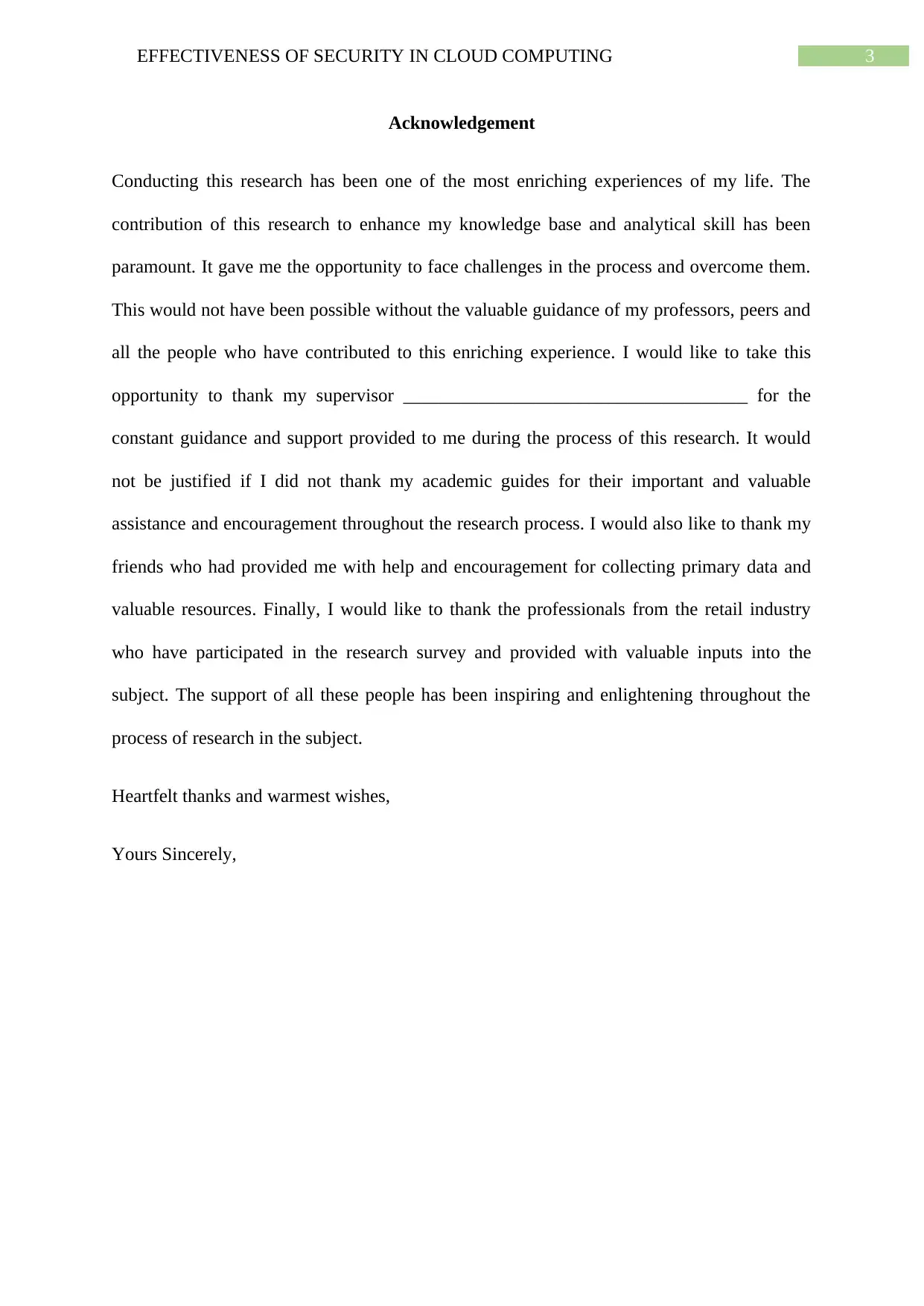
3EFFECTIVENESS OF SECURITY IN CLOUD COMPUTING
Acknowledgement
Conducting this research has been one of the most enriching experiences of my life. The
contribution of this research to enhance my knowledge base and analytical skill has been
paramount. It gave me the opportunity to face challenges in the process and overcome them.
This would not have been possible without the valuable guidance of my professors, peers and
all the people who have contributed to this enriching experience. I would like to take this
opportunity to thank my supervisor _____________________________________ for the
constant guidance and support provided to me during the process of this research. It would
not be justified if I did not thank my academic guides for their important and valuable
assistance and encouragement throughout the research process. I would also like to thank my
friends who had provided me with help and encouragement for collecting primary data and
valuable resources. Finally, I would like to thank the professionals from the retail industry
who have participated in the research survey and provided with valuable inputs into the
subject. The support of all these people has been inspiring and enlightening throughout the
process of research in the subject.
Heartfelt thanks and warmest wishes,
Yours Sincerely,
Acknowledgement
Conducting this research has been one of the most enriching experiences of my life. The
contribution of this research to enhance my knowledge base and analytical skill has been
paramount. It gave me the opportunity to face challenges in the process and overcome them.
This would not have been possible without the valuable guidance of my professors, peers and
all the people who have contributed to this enriching experience. I would like to take this
opportunity to thank my supervisor _____________________________________ for the
constant guidance and support provided to me during the process of this research. It would
not be justified if I did not thank my academic guides for their important and valuable
assistance and encouragement throughout the research process. I would also like to thank my
friends who had provided me with help and encouragement for collecting primary data and
valuable resources. Finally, I would like to thank the professionals from the retail industry
who have participated in the research survey and provided with valuable inputs into the
subject. The support of all these people has been inspiring and enlightening throughout the
process of research in the subject.
Heartfelt thanks and warmest wishes,
Yours Sincerely,
⊘ This is a preview!⊘
Do you want full access?
Subscribe today to unlock all pages.

Trusted by 1+ million students worldwide
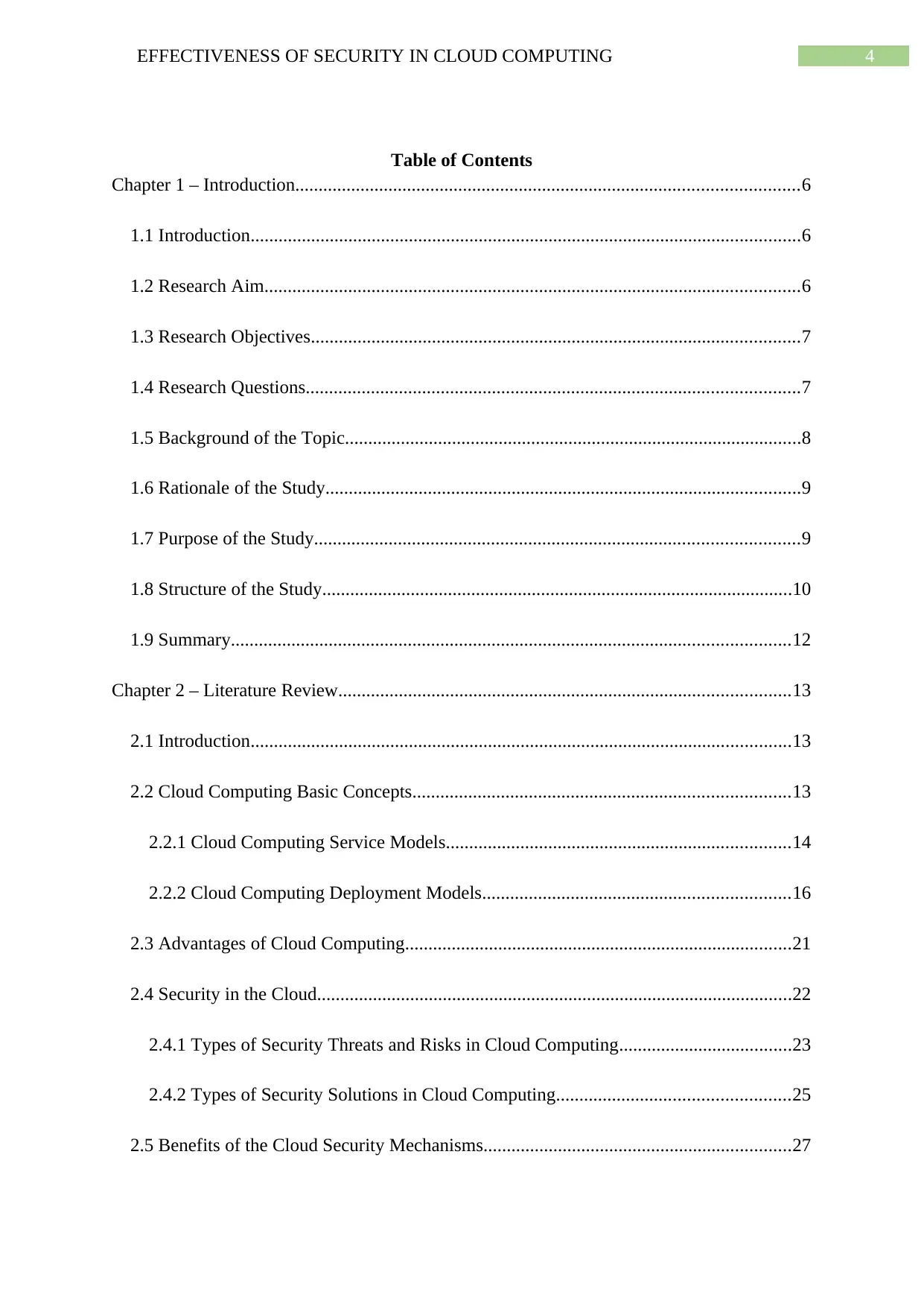
4EFFECTIVENESS OF SECURITY IN CLOUD COMPUTING
Table of Contents
Chapter 1 – Introduction............................................................................................................6
1.1 Introduction......................................................................................................................6
1.2 Research Aim...................................................................................................................6
1.3 Research Objectives.........................................................................................................7
1.4 Research Questions..........................................................................................................7
1.5 Background of the Topic..................................................................................................8
1.6 Rationale of the Study......................................................................................................9
1.7 Purpose of the Study........................................................................................................9
1.8 Structure of the Study.....................................................................................................10
1.9 Summary........................................................................................................................12
Chapter 2 – Literature Review.................................................................................................13
2.1 Introduction....................................................................................................................13
2.2 Cloud Computing Basic Concepts.................................................................................13
2.2.1 Cloud Computing Service Models..........................................................................14
2.2.2 Cloud Computing Deployment Models..................................................................16
2.3 Advantages of Cloud Computing...................................................................................21
2.4 Security in the Cloud......................................................................................................22
2.4.1 Types of Security Threats and Risks in Cloud Computing.....................................23
2.4.2 Types of Security Solutions in Cloud Computing..................................................25
2.5 Benefits of the Cloud Security Mechanisms..................................................................27
Table of Contents
Chapter 1 – Introduction............................................................................................................6
1.1 Introduction......................................................................................................................6
1.2 Research Aim...................................................................................................................6
1.3 Research Objectives.........................................................................................................7
1.4 Research Questions..........................................................................................................7
1.5 Background of the Topic..................................................................................................8
1.6 Rationale of the Study......................................................................................................9
1.7 Purpose of the Study........................................................................................................9
1.8 Structure of the Study.....................................................................................................10
1.9 Summary........................................................................................................................12
Chapter 2 – Literature Review.................................................................................................13
2.1 Introduction....................................................................................................................13
2.2 Cloud Computing Basic Concepts.................................................................................13
2.2.1 Cloud Computing Service Models..........................................................................14
2.2.2 Cloud Computing Deployment Models..................................................................16
2.3 Advantages of Cloud Computing...................................................................................21
2.4 Security in the Cloud......................................................................................................22
2.4.1 Types of Security Threats and Risks in Cloud Computing.....................................23
2.4.2 Types of Security Solutions in Cloud Computing..................................................25
2.5 Benefits of the Cloud Security Mechanisms..................................................................27
Paraphrase This Document
Need a fresh take? Get an instant paraphrase of this document with our AI Paraphraser
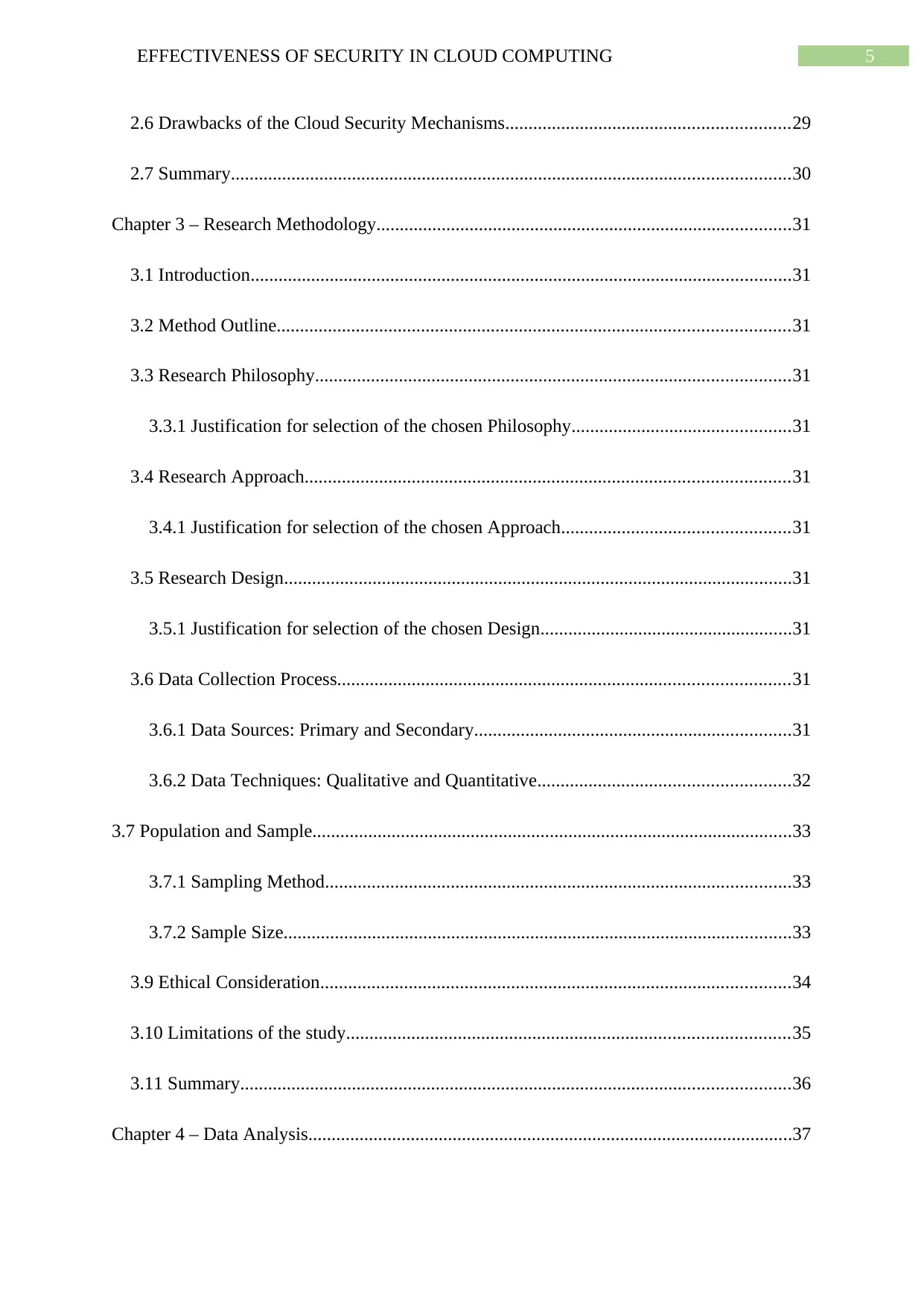
5EFFECTIVENESS OF SECURITY IN CLOUD COMPUTING
2.6 Drawbacks of the Cloud Security Mechanisms.............................................................29
2.7 Summary........................................................................................................................30
Chapter 3 – Research Methodology.........................................................................................31
3.1 Introduction....................................................................................................................31
3.2 Method Outline..............................................................................................................31
3.3 Research Philosophy......................................................................................................31
3.3.1 Justification for selection of the chosen Philosophy...............................................31
3.4 Research Approach........................................................................................................31
3.4.1 Justification for selection of the chosen Approach.................................................31
3.5 Research Design.............................................................................................................31
3.5.1 Justification for selection of the chosen Design......................................................31
3.6 Data Collection Process.................................................................................................31
3.6.1 Data Sources: Primary and Secondary....................................................................31
3.6.2 Data Techniques: Qualitative and Quantitative......................................................32
3.7 Population and Sample.......................................................................................................33
3.7.1 Sampling Method....................................................................................................33
3.7.2 Sample Size.............................................................................................................33
3.9 Ethical Consideration.....................................................................................................34
3.10 Limitations of the study...............................................................................................35
3.11 Summary......................................................................................................................36
Chapter 4 – Data Analysis........................................................................................................37
2.6 Drawbacks of the Cloud Security Mechanisms.............................................................29
2.7 Summary........................................................................................................................30
Chapter 3 – Research Methodology.........................................................................................31
3.1 Introduction....................................................................................................................31
3.2 Method Outline..............................................................................................................31
3.3 Research Philosophy......................................................................................................31
3.3.1 Justification for selection of the chosen Philosophy...............................................31
3.4 Research Approach........................................................................................................31
3.4.1 Justification for selection of the chosen Approach.................................................31
3.5 Research Design.............................................................................................................31
3.5.1 Justification for selection of the chosen Design......................................................31
3.6 Data Collection Process.................................................................................................31
3.6.1 Data Sources: Primary and Secondary....................................................................31
3.6.2 Data Techniques: Qualitative and Quantitative......................................................32
3.7 Population and Sample.......................................................................................................33
3.7.1 Sampling Method....................................................................................................33
3.7.2 Sample Size.............................................................................................................33
3.9 Ethical Consideration.....................................................................................................34
3.10 Limitations of the study...............................................................................................35
3.11 Summary......................................................................................................................36
Chapter 4 – Data Analysis........................................................................................................37
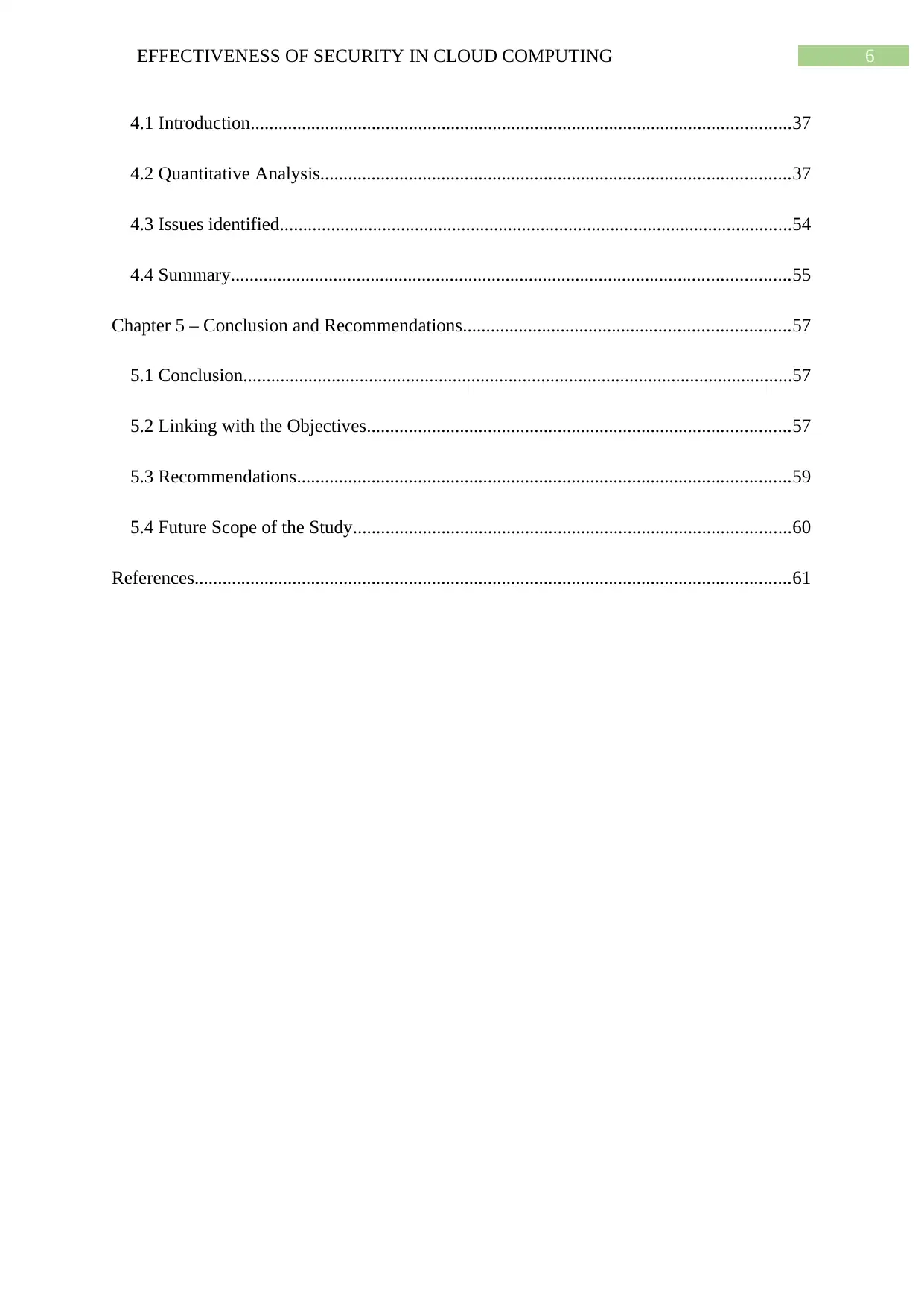
6EFFECTIVENESS OF SECURITY IN CLOUD COMPUTING
4.1 Introduction....................................................................................................................37
4.2 Quantitative Analysis.....................................................................................................37
4.3 Issues identified..............................................................................................................54
4.4 Summary........................................................................................................................55
Chapter 5 – Conclusion and Recommendations......................................................................57
5.1 Conclusion......................................................................................................................57
5.2 Linking with the Objectives...........................................................................................57
5.3 Recommendations..........................................................................................................59
5.4 Future Scope of the Study..............................................................................................60
References................................................................................................................................61
4.1 Introduction....................................................................................................................37
4.2 Quantitative Analysis.....................................................................................................37
4.3 Issues identified..............................................................................................................54
4.4 Summary........................................................................................................................55
Chapter 5 – Conclusion and Recommendations......................................................................57
5.1 Conclusion......................................................................................................................57
5.2 Linking with the Objectives...........................................................................................57
5.3 Recommendations..........................................................................................................59
5.4 Future Scope of the Study..............................................................................................60
References................................................................................................................................61
⊘ This is a preview!⊘
Do you want full access?
Subscribe today to unlock all pages.

Trusted by 1+ million students worldwide
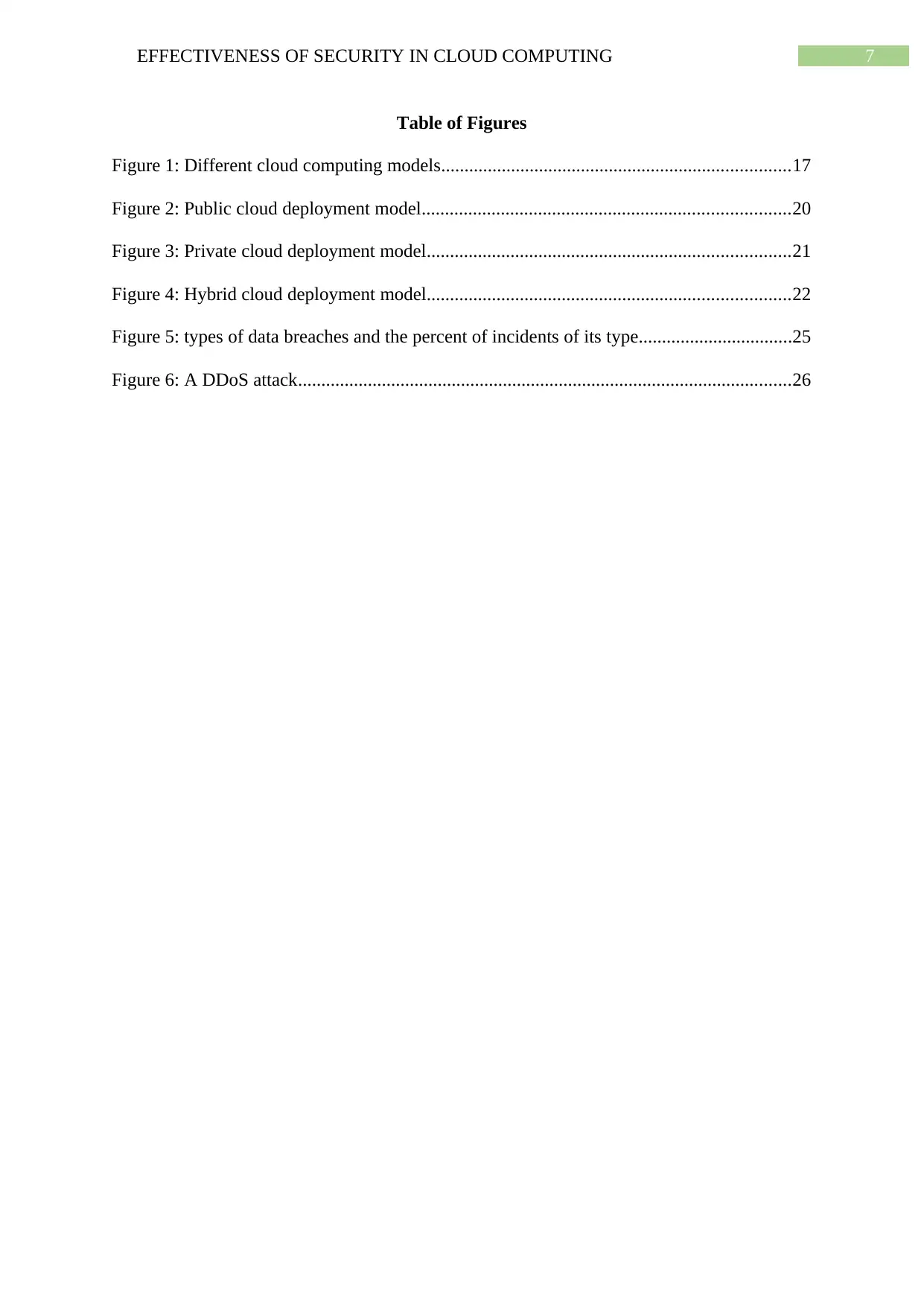
7EFFECTIVENESS OF SECURITY IN CLOUD COMPUTING
Table of Figures
Figure 1: Different cloud computing models...........................................................................17
Figure 2: Public cloud deployment model...............................................................................20
Figure 3: Private cloud deployment model..............................................................................21
Figure 4: Hybrid cloud deployment model..............................................................................22
Figure 5: types of data breaches and the percent of incidents of its type.................................25
Figure 6: A DDoS attack..........................................................................................................26
Table of Figures
Figure 1: Different cloud computing models...........................................................................17
Figure 2: Public cloud deployment model...............................................................................20
Figure 3: Private cloud deployment model..............................................................................21
Figure 4: Hybrid cloud deployment model..............................................................................22
Figure 5: types of data breaches and the percent of incidents of its type.................................25
Figure 6: A DDoS attack..........................................................................................................26
Paraphrase This Document
Need a fresh take? Get an instant paraphrase of this document with our AI Paraphraser
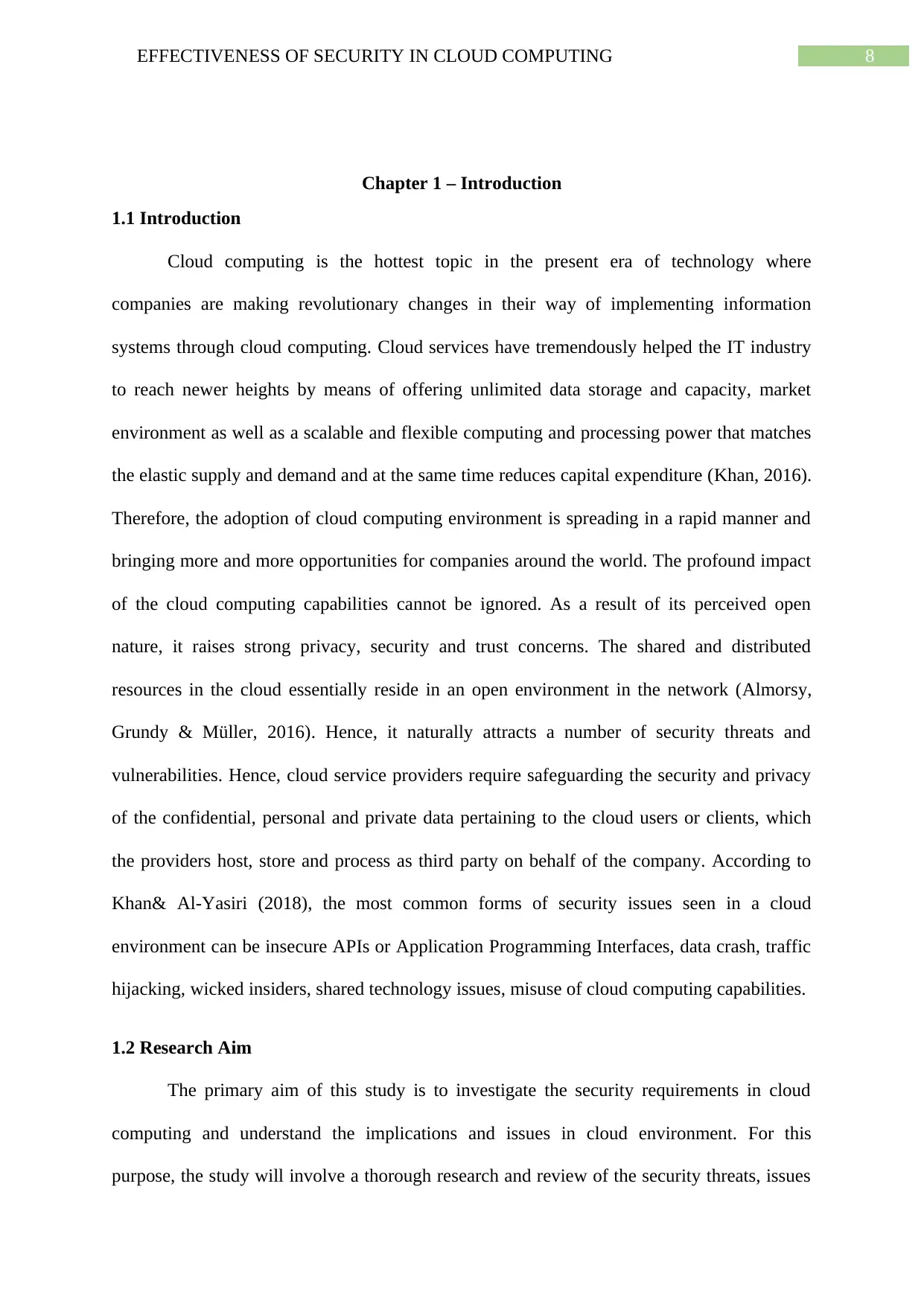
8EFFECTIVENESS OF SECURITY IN CLOUD COMPUTING
Chapter 1 – Introduction
1.1 Introduction
Cloud computing is the hottest topic in the present era of technology where
companies are making revolutionary changes in their way of implementing information
systems through cloud computing. Cloud services have tremendously helped the IT industry
to reach newer heights by means of offering unlimited data storage and capacity, market
environment as well as a scalable and flexible computing and processing power that matches
the elastic supply and demand and at the same time reduces capital expenditure (Khan, 2016).
Therefore, the adoption of cloud computing environment is spreading in a rapid manner and
bringing more and more opportunities for companies around the world. The profound impact
of the cloud computing capabilities cannot be ignored. As a result of its perceived open
nature, it raises strong privacy, security and trust concerns. The shared and distributed
resources in the cloud essentially reside in an open environment in the network (Almorsy,
Grundy & Müller, 2016). Hence, it naturally attracts a number of security threats and
vulnerabilities. Hence, cloud service providers require safeguarding the security and privacy
of the confidential, personal and private data pertaining to the cloud users or clients, which
the providers host, store and process as third party on behalf of the company. According to
Khan& Al-Yasiri (2018), the most common forms of security issues seen in a cloud
environment can be insecure APIs or Application Programming Interfaces, data crash, traffic
hijacking, wicked insiders, shared technology issues, misuse of cloud computing capabilities.
1.2 Research Aim
The primary aim of this study is to investigate the security requirements in cloud
computing and understand the implications and issues in cloud environment. For this
purpose, the study will involve a thorough research and review of the security threats, issues
Chapter 1 – Introduction
1.1 Introduction
Cloud computing is the hottest topic in the present era of technology where
companies are making revolutionary changes in their way of implementing information
systems through cloud computing. Cloud services have tremendously helped the IT industry
to reach newer heights by means of offering unlimited data storage and capacity, market
environment as well as a scalable and flexible computing and processing power that matches
the elastic supply and demand and at the same time reduces capital expenditure (Khan, 2016).
Therefore, the adoption of cloud computing environment is spreading in a rapid manner and
bringing more and more opportunities for companies around the world. The profound impact
of the cloud computing capabilities cannot be ignored. As a result of its perceived open
nature, it raises strong privacy, security and trust concerns. The shared and distributed
resources in the cloud essentially reside in an open environment in the network (Almorsy,
Grundy & Müller, 2016). Hence, it naturally attracts a number of security threats and
vulnerabilities. Hence, cloud service providers require safeguarding the security and privacy
of the confidential, personal and private data pertaining to the cloud users or clients, which
the providers host, store and process as third party on behalf of the company. According to
Khan& Al-Yasiri (2018), the most common forms of security issues seen in a cloud
environment can be insecure APIs or Application Programming Interfaces, data crash, traffic
hijacking, wicked insiders, shared technology issues, misuse of cloud computing capabilities.
1.2 Research Aim
The primary aim of this study is to investigate the security requirements in cloud
computing and understand the implications and issues in cloud environment. For this
purpose, the study will involve a thorough research and review of the security threats, issues
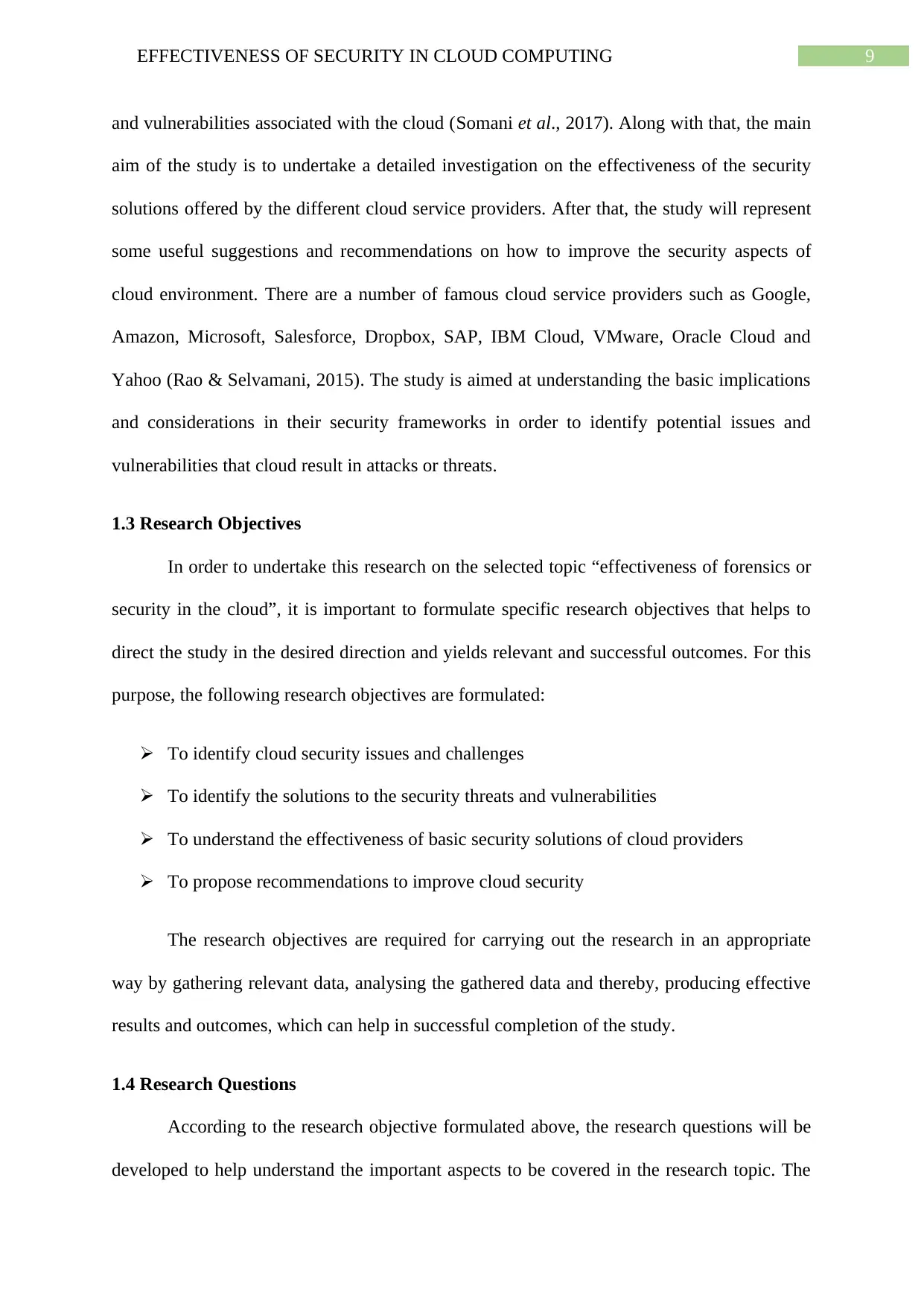
9EFFECTIVENESS OF SECURITY IN CLOUD COMPUTING
and vulnerabilities associated with the cloud (Somani et al., 2017). Along with that, the main
aim of the study is to undertake a detailed investigation on the effectiveness of the security
solutions offered by the different cloud service providers. After that, the study will represent
some useful suggestions and recommendations on how to improve the security aspects of
cloud environment. There are a number of famous cloud service providers such as Google,
Amazon, Microsoft, Salesforce, Dropbox, SAP, IBM Cloud, VMware, Oracle Cloud and
Yahoo (Rao & Selvamani, 2015). The study is aimed at understanding the basic implications
and considerations in their security frameworks in order to identify potential issues and
vulnerabilities that cloud result in attacks or threats.
1.3 Research Objectives
In order to undertake this research on the selected topic “effectiveness of forensics or
security in the cloud”, it is important to formulate specific research objectives that helps to
direct the study in the desired direction and yields relevant and successful outcomes. For this
purpose, the following research objectives are formulated:
To identify cloud security issues and challenges
To identify the solutions to the security threats and vulnerabilities
To understand the effectiveness of basic security solutions of cloud providers
To propose recommendations to improve cloud security
The research objectives are required for carrying out the research in an appropriate
way by gathering relevant data, analysing the gathered data and thereby, producing effective
results and outcomes, which can help in successful completion of the study.
1.4 Research Questions
According to the research objective formulated above, the research questions will be
developed to help understand the important aspects to be covered in the research topic. The
and vulnerabilities associated with the cloud (Somani et al., 2017). Along with that, the main
aim of the study is to undertake a detailed investigation on the effectiveness of the security
solutions offered by the different cloud service providers. After that, the study will represent
some useful suggestions and recommendations on how to improve the security aspects of
cloud environment. There are a number of famous cloud service providers such as Google,
Amazon, Microsoft, Salesforce, Dropbox, SAP, IBM Cloud, VMware, Oracle Cloud and
Yahoo (Rao & Selvamani, 2015). The study is aimed at understanding the basic implications
and considerations in their security frameworks in order to identify potential issues and
vulnerabilities that cloud result in attacks or threats.
1.3 Research Objectives
In order to undertake this research on the selected topic “effectiveness of forensics or
security in the cloud”, it is important to formulate specific research objectives that helps to
direct the study in the desired direction and yields relevant and successful outcomes. For this
purpose, the following research objectives are formulated:
To identify cloud security issues and challenges
To identify the solutions to the security threats and vulnerabilities
To understand the effectiveness of basic security solutions of cloud providers
To propose recommendations to improve cloud security
The research objectives are required for carrying out the research in an appropriate
way by gathering relevant data, analysing the gathered data and thereby, producing effective
results and outcomes, which can help in successful completion of the study.
1.4 Research Questions
According to the research objective formulated above, the research questions will be
developed to help understand the important aspects to be covered in the research topic. The
⊘ This is a preview!⊘
Do you want full access?
Subscribe today to unlock all pages.

Trusted by 1+ million students worldwide
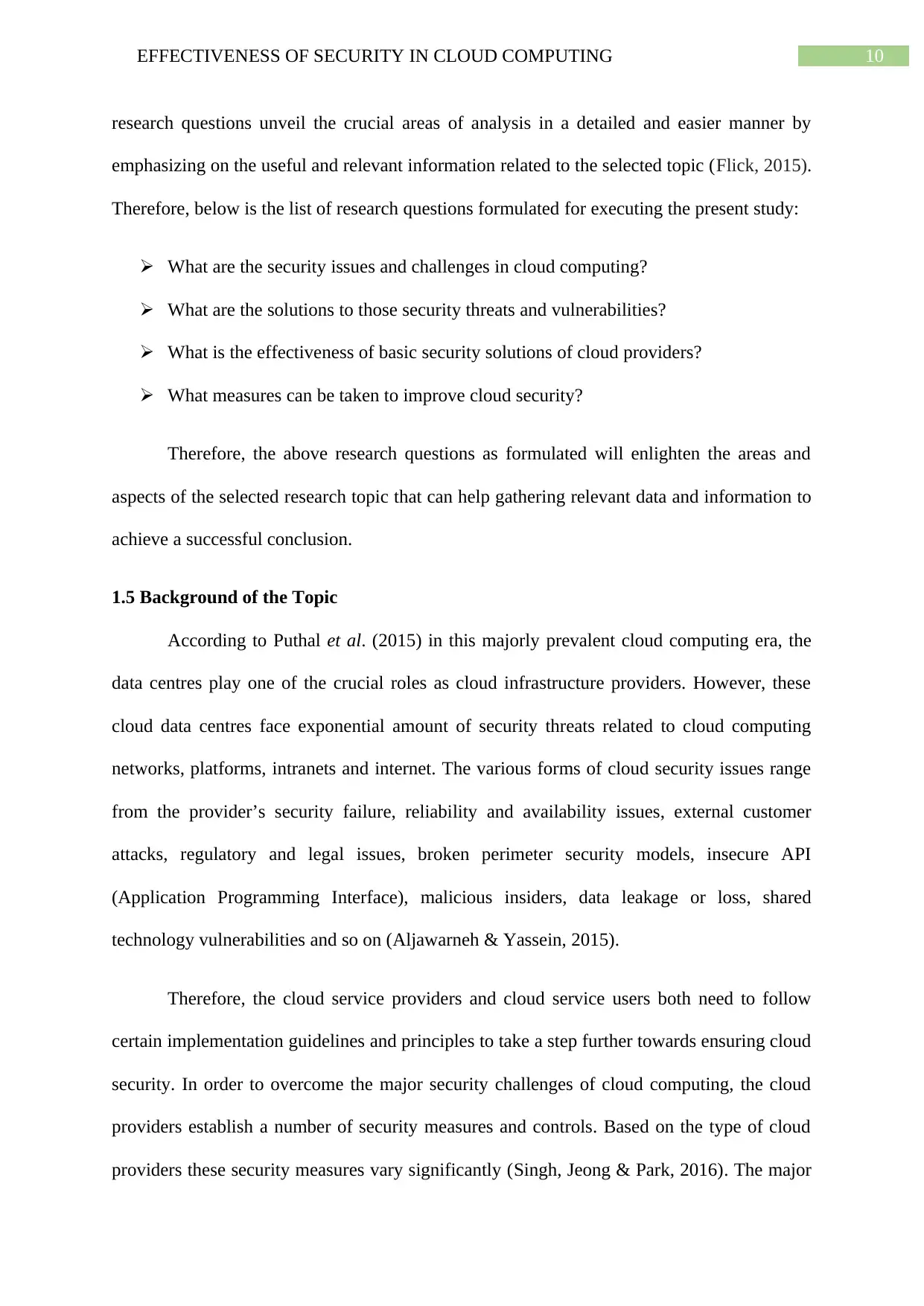
10EFFECTIVENESS OF SECURITY IN CLOUD COMPUTING
research questions unveil the crucial areas of analysis in a detailed and easier manner by
emphasizing on the useful and relevant information related to the selected topic (Flick, 2015).
Therefore, below is the list of research questions formulated for executing the present study:
What are the security issues and challenges in cloud computing?
What are the solutions to those security threats and vulnerabilities?
What is the effectiveness of basic security solutions of cloud providers?
What measures can be taken to improve cloud security?
Therefore, the above research questions as formulated will enlighten the areas and
aspects of the selected research topic that can help gathering relevant data and information to
achieve a successful conclusion.
1.5 Background of the Topic
According to Puthal et al. (2015) in this majorly prevalent cloud computing era, the
data centres play one of the crucial roles as cloud infrastructure providers. However, these
cloud data centres face exponential amount of security threats related to cloud computing
networks, platforms, intranets and internet. The various forms of cloud security issues range
from the provider’s security failure, reliability and availability issues, external customer
attacks, regulatory and legal issues, broken perimeter security models, insecure API
(Application Programming Interface), malicious insiders, data leakage or loss, shared
technology vulnerabilities and so on (Aljawarneh & Yassein, 2015).
Therefore, the cloud service providers and cloud service users both need to follow
certain implementation guidelines and principles to take a step further towards ensuring cloud
security. In order to overcome the major security challenges of cloud computing, the cloud
providers establish a number of security measures and controls. Based on the type of cloud
providers these security measures vary significantly (Singh, Jeong & Park, 2016). The major
research questions unveil the crucial areas of analysis in a detailed and easier manner by
emphasizing on the useful and relevant information related to the selected topic (Flick, 2015).
Therefore, below is the list of research questions formulated for executing the present study:
What are the security issues and challenges in cloud computing?
What are the solutions to those security threats and vulnerabilities?
What is the effectiveness of basic security solutions of cloud providers?
What measures can be taken to improve cloud security?
Therefore, the above research questions as formulated will enlighten the areas and
aspects of the selected research topic that can help gathering relevant data and information to
achieve a successful conclusion.
1.5 Background of the Topic
According to Puthal et al. (2015) in this majorly prevalent cloud computing era, the
data centres play one of the crucial roles as cloud infrastructure providers. However, these
cloud data centres face exponential amount of security threats related to cloud computing
networks, platforms, intranets and internet. The various forms of cloud security issues range
from the provider’s security failure, reliability and availability issues, external customer
attacks, regulatory and legal issues, broken perimeter security models, insecure API
(Application Programming Interface), malicious insiders, data leakage or loss, shared
technology vulnerabilities and so on (Aljawarneh & Yassein, 2015).
Therefore, the cloud service providers and cloud service users both need to follow
certain implementation guidelines and principles to take a step further towards ensuring cloud
security. In order to overcome the major security challenges of cloud computing, the cloud
providers establish a number of security measures and controls. Based on the type of cloud
providers these security measures vary significantly (Singh, Jeong & Park, 2016). The major
Paraphrase This Document
Need a fresh take? Get an instant paraphrase of this document with our AI Paraphraser
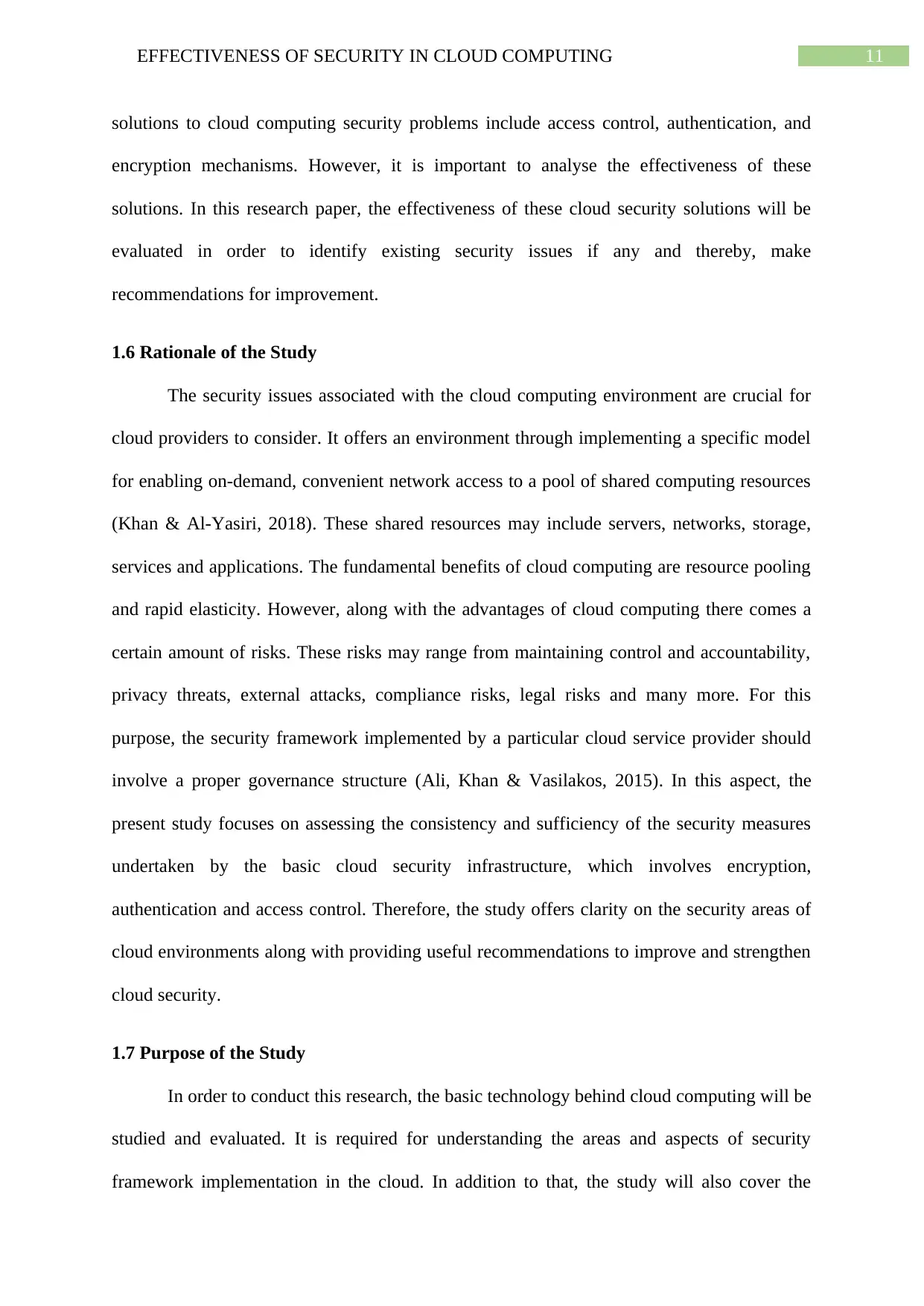
11EFFECTIVENESS OF SECURITY IN CLOUD COMPUTING
solutions to cloud computing security problems include access control, authentication, and
encryption mechanisms. However, it is important to analyse the effectiveness of these
solutions. In this research paper, the effectiveness of these cloud security solutions will be
evaluated in order to identify existing security issues if any and thereby, make
recommendations for improvement.
1.6 Rationale of the Study
The security issues associated with the cloud computing environment are crucial for
cloud providers to consider. It offers an environment through implementing a specific model
for enabling on-demand, convenient network access to a pool of shared computing resources
(Khan & Al-Yasiri, 2018). These shared resources may include servers, networks, storage,
services and applications. The fundamental benefits of cloud computing are resource pooling
and rapid elasticity. However, along with the advantages of cloud computing there comes a
certain amount of risks. These risks may range from maintaining control and accountability,
privacy threats, external attacks, compliance risks, legal risks and many more. For this
purpose, the security framework implemented by a particular cloud service provider should
involve a proper governance structure (Ali, Khan & Vasilakos, 2015). In this aspect, the
present study focuses on assessing the consistency and sufficiency of the security measures
undertaken by the basic cloud security infrastructure, which involves encryption,
authentication and access control. Therefore, the study offers clarity on the security areas of
cloud environments along with providing useful recommendations to improve and strengthen
cloud security.
1.7 Purpose of the Study
In order to conduct this research, the basic technology behind cloud computing will be
studied and evaluated. It is required for understanding the areas and aspects of security
framework implementation in the cloud. In addition to that, the study will also cover the
solutions to cloud computing security problems include access control, authentication, and
encryption mechanisms. However, it is important to analyse the effectiveness of these
solutions. In this research paper, the effectiveness of these cloud security solutions will be
evaluated in order to identify existing security issues if any and thereby, make
recommendations for improvement.
1.6 Rationale of the Study
The security issues associated with the cloud computing environment are crucial for
cloud providers to consider. It offers an environment through implementing a specific model
for enabling on-demand, convenient network access to a pool of shared computing resources
(Khan & Al-Yasiri, 2018). These shared resources may include servers, networks, storage,
services and applications. The fundamental benefits of cloud computing are resource pooling
and rapid elasticity. However, along with the advantages of cloud computing there comes a
certain amount of risks. These risks may range from maintaining control and accountability,
privacy threats, external attacks, compliance risks, legal risks and many more. For this
purpose, the security framework implemented by a particular cloud service provider should
involve a proper governance structure (Ali, Khan & Vasilakos, 2015). In this aspect, the
present study focuses on assessing the consistency and sufficiency of the security measures
undertaken by the basic cloud security infrastructure, which involves encryption,
authentication and access control. Therefore, the study offers clarity on the security areas of
cloud environments along with providing useful recommendations to improve and strengthen
cloud security.
1.7 Purpose of the Study
In order to conduct this research, the basic technology behind cloud computing will be
studied and evaluated. It is required for understanding the areas and aspects of security
framework implementation in the cloud. In addition to that, the study will also cover the
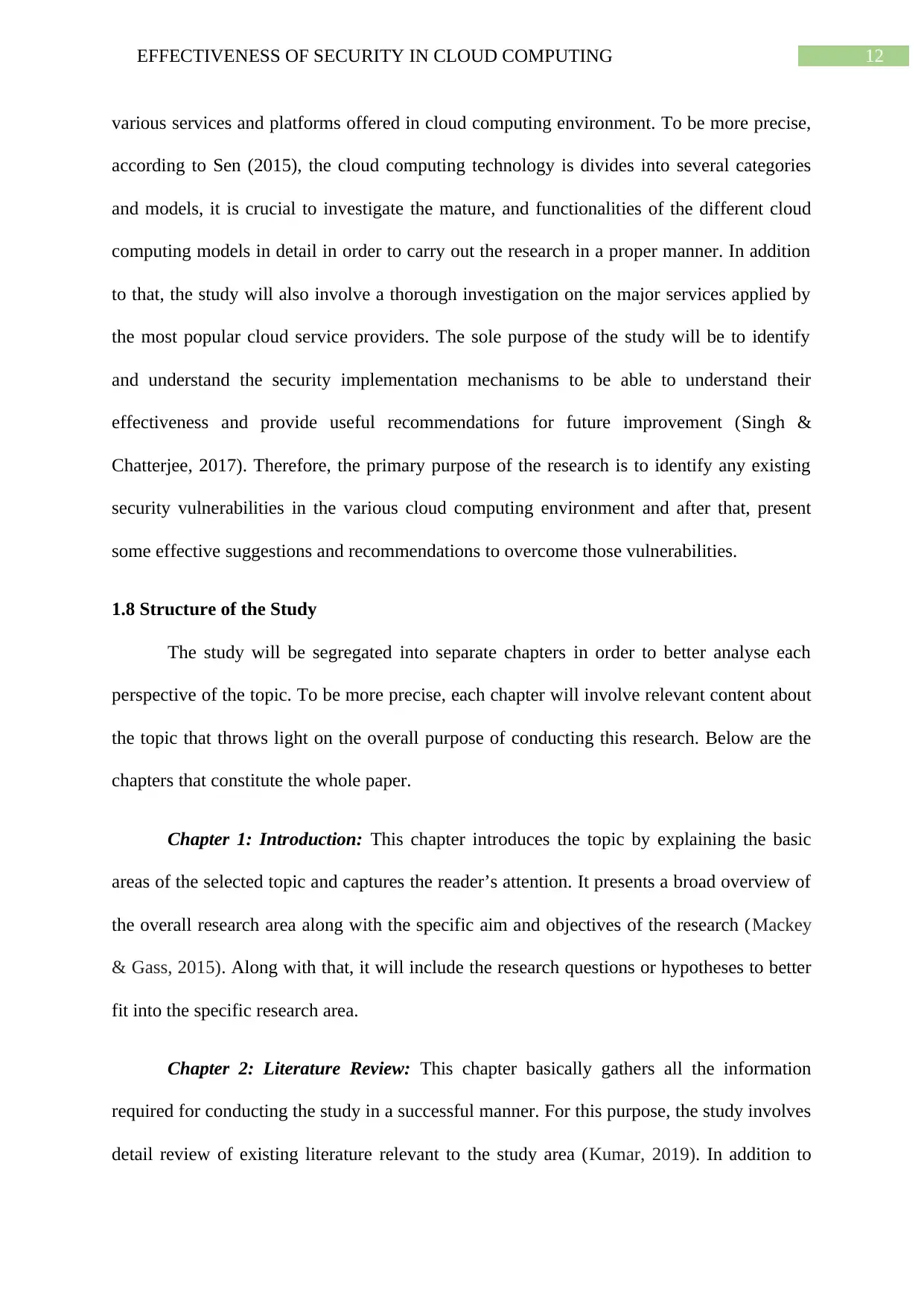
12EFFECTIVENESS OF SECURITY IN CLOUD COMPUTING
various services and platforms offered in cloud computing environment. To be more precise,
according to Sen (2015), the cloud computing technology is divides into several categories
and models, it is crucial to investigate the mature, and functionalities of the different cloud
computing models in detail in order to carry out the research in a proper manner. In addition
to that, the study will also involve a thorough investigation on the major services applied by
the most popular cloud service providers. The sole purpose of the study will be to identify
and understand the security implementation mechanisms to be able to understand their
effectiveness and provide useful recommendations for future improvement (Singh &
Chatterjee, 2017). Therefore, the primary purpose of the research is to identify any existing
security vulnerabilities in the various cloud computing environment and after that, present
some effective suggestions and recommendations to overcome those vulnerabilities.
1.8 Structure of the Study
The study will be segregated into separate chapters in order to better analyse each
perspective of the topic. To be more precise, each chapter will involve relevant content about
the topic that throws light on the overall purpose of conducting this research. Below are the
chapters that constitute the whole paper.
Chapter 1: Introduction: This chapter introduces the topic by explaining the basic
areas of the selected topic and captures the reader’s attention. It presents a broad overview of
the overall research area along with the specific aim and objectives of the research (Mackey
& Gass, 2015). Along with that, it will include the research questions or hypotheses to better
fit into the specific research area.
Chapter 2: Literature Review: This chapter basically gathers all the information
required for conducting the study in a successful manner. For this purpose, the study involves
detail review of existing literature relevant to the study area (Kumar, 2019). In addition to
various services and platforms offered in cloud computing environment. To be more precise,
according to Sen (2015), the cloud computing technology is divides into several categories
and models, it is crucial to investigate the mature, and functionalities of the different cloud
computing models in detail in order to carry out the research in a proper manner. In addition
to that, the study will also involve a thorough investigation on the major services applied by
the most popular cloud service providers. The sole purpose of the study will be to identify
and understand the security implementation mechanisms to be able to understand their
effectiveness and provide useful recommendations for future improvement (Singh &
Chatterjee, 2017). Therefore, the primary purpose of the research is to identify any existing
security vulnerabilities in the various cloud computing environment and after that, present
some effective suggestions and recommendations to overcome those vulnerabilities.
1.8 Structure of the Study
The study will be segregated into separate chapters in order to better analyse each
perspective of the topic. To be more precise, each chapter will involve relevant content about
the topic that throws light on the overall purpose of conducting this research. Below are the
chapters that constitute the whole paper.
Chapter 1: Introduction: This chapter introduces the topic by explaining the basic
areas of the selected topic and captures the reader’s attention. It presents a broad overview of
the overall research area along with the specific aim and objectives of the research (Mackey
& Gass, 2015). Along with that, it will include the research questions or hypotheses to better
fit into the specific research area.
Chapter 2: Literature Review: This chapter basically gathers all the information
required for conducting the study in a successful manner. For this purpose, the study involves
detail review of existing literature relevant to the study area (Kumar, 2019). In addition to
⊘ This is a preview!⊘
Do you want full access?
Subscribe today to unlock all pages.

Trusted by 1+ million students worldwide
1 out of 71
Related Documents
Your All-in-One AI-Powered Toolkit for Academic Success.
+13062052269
info@desklib.com
Available 24*7 on WhatsApp / Email
![[object Object]](/_next/static/media/star-bottom.7253800d.svg)
Unlock your academic potential
Copyright © 2020–2025 A2Z Services. All Rights Reserved. Developed and managed by ZUCOL.





